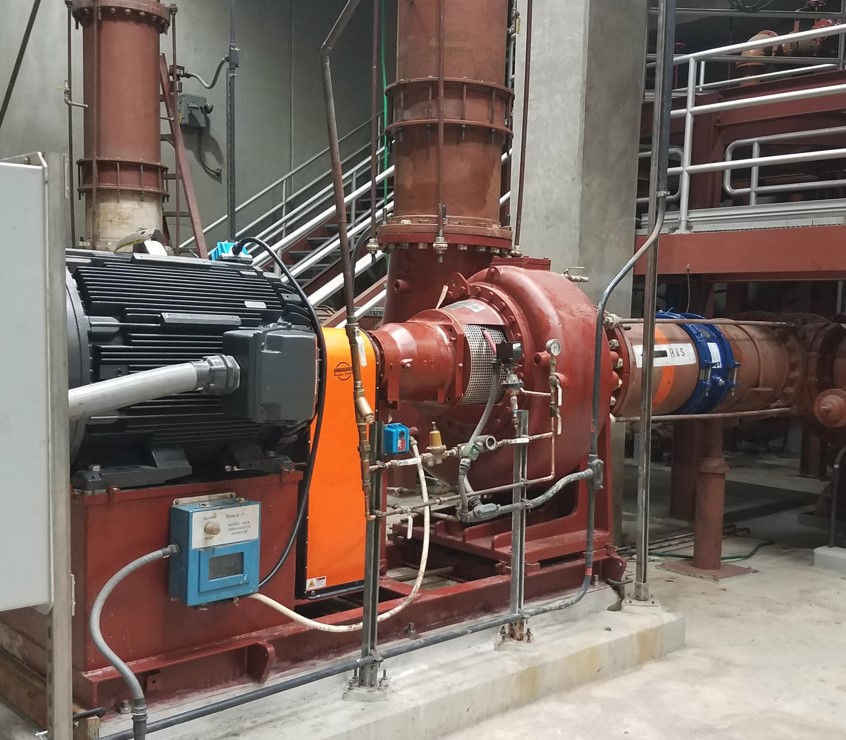
UPGRADE WASTEWATER PUMP BEARINGS FOR LONGER LIFE
Overview
Wastewater pumps and sump pumps cause maintenance headaches for plants around the world. The most common reason for maintenance is worn out shaft bearings. Fortunately, with some analysis and superior materials, you can make these pumps last for years. We have helped customers upgrade hundreds of these pumps over the years, so if you are having issues with your wastewater or process sump pumps, contact Boulden today.
Define the Service
The first step in improving the life of these pumps is to properly define the service. “Sump pump” and “wastewater pump” are generic terms encompassing a wide range of services. Some services are primarily chemicals mixed with water; others are pumping storm water runoff; others are somewhere in between. Most of these processes run near ambient temperature, but some process sumps can be quite hot. To recommend the right material, it helps to understand the potential chemicals involved, the level of dirt or abrasives, and the range of operating temperatures.
Understand the Pump Type
Wastewater services generally use API610 Type VS4 pumps. This design involves a vertically suspended shaft supported by one or more bearings with a single stage impeller at the bottom. The impeller pumps the process liquid into separate discharge piping outside of the shaft column.
The separate discharge column in the VS4 pump design makes the shaft bearing application quite difficult. Because the bearings are generally located above the liquid level in the sump, some kind of provision to flush the bearings is required.
There are several options to flush or lubricate the bearings, and none of the options are perfect—one of the reasons why bearing failures are so common in these pumps. The main options are to use a flush from the pump discharge, a water flush, or greased bearings.
Discharge Flush
The default design for most installations is to flush the bearings with a line from the pump discharge. This has the advantage of not requiring any auxiliary system, everything can be assembled at the pump factory, and the system automatically works when the pump runs. The main challenges are that the bearings need to survive dry running for a short time at start up and most wastewater streams are relatively dirty. Flushing dirt into a bearing surface is always undesirable.
That said, if you can find a bearing material that can run dry at start up and can reasonably handle the solids in the process stream, this is the simplest arrangement for these pumps and can be quite reliable.
A discharge flush is also the typical arrangement in chemical sumps. In chemical sumps, the challenge of running dry at start up remains, combined with a potential mix of chemicals which can be quite aggressive.
Plants around the world have upgraded their wastewater pumps using Boulden B-1050 shaft bearings running with a discharge flush. Contact us today to see if this option is right for you.
Water Flush
Probably the next most common method of flushing the bearings is to use an outside source of water. This arrangement has some attractive advantages in that the flush can potentially begin before the pump starts to avoid dry running at the bearings. A clean water source also eliminates the dirt and solids in the bearings. When this arrangement works, the pumps can run for many years without failure.
Unfortunately, an outside water flush has some drawbacks. First, clean water costs money. Then, when it is flushed into your wastewater system, you have to pay the treatment costs. A typical cost in Europe is about €4.50/1000 liters. In the USA, a typical cost for water plus treatment is $8.00/1000 gallons. Assuming a flush rate of only 4 liters/minute (approx. 1 gpm), the cost of a clean water flush can be €9,000/year in Europe or $4,000/year in the USA. Obviously, these values can vary widely depending on location—some areas will have lower costs and some areas will have much higher costs.
Water flush is also only as reliable as the system. Operator errors, faulty solenoid valves, and plugged lines can cause the flush to fail, which generally leads to bearing failure. Furthermore, because the water costs money, most plants try to restrict the flow rate which requires bearing materials that can survive with marginal lubrication.
Drawbacks aside, in extremely dirty wastewater services, a clean water flush might be the best option. The good news is that Boulden has materials which can run with minimal flush flow rates and survive for many years.
Greased Bearings
Less frequently, the bearings on these pumps will be greased. The main issue again is the reliability of the greasing system. Operator errors or failures of an automatic greasing system will shorten the bearing life. Again, bearing materials from Boulden which can run with marginal lubrication conditions will help these pumps be more reliable.
Conclusion
One of the fastest and easiest ways to make your sump pumps or wastewater pumps more reliable is to use better shaft bearing materials. Next time you have one of these pumps in your shop, think of Boulden. Boulden B-1050 is a great choice for most of these applications. We have it in stock and can ship almost anywhere in the world in a matter of days. We can supply raw material and help you with any questions on design, machining, and installation; or, we can make the parts for you. Contact us to discuss your application today.
